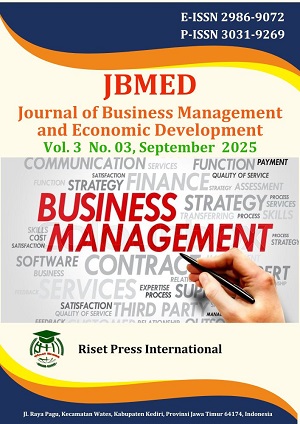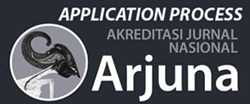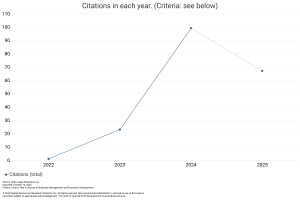State Control, User Experience, and Purchase Intentions in the Digital Economy: Empirical Evidence from Vietnam
DOI:
https://doi.org/10.59653/jbmed.v3i03.1896Keywords:
Selected:User Experience, Purchase decision, PLS-SEMAbstract
The rapid growth of digital commerce has reshaped consumer behavior, highlighting the role of state control, social media interaction (SMI), and user experience (UX) in influencing purchase decisions (PD). This study explores how government policies and regulations on digital platforms influence user engagement and online experiences, influencing purchase behavior. Drawing on institutional theory, the theory of planned behavior (TPB), and the unified theory of acceptance and use of technology (UTAUT2), the study develops and tests a conceptual model linking these factors. Data were collected from a quantitative survey of social media users in Vietnam and then analyzed using structural equation modeling (PLS-SEM). The results show that state control does not directly affect shopping behavior but mainly indirectly through social media interaction and user experience. At the same time, user experience plays the most important role in driving purchase decisions, emphasizing the importance of convenience, trust, and satisfaction when using digital platforms. In terms of practical applications, the study recommends that businesses optimize customer experience through intuitive and personalized digital interfaces based on AI while encouraging participation and interaction on the platform. The government must focus on building a safe digital ecosystem, strengthening the legal framework, and supporting small and medium-sized enterprises (SMEs) to participate in e-commerce. This study contributes to the literature by integrating state control as a factor influencing consumer behavior while providing useful, practical suggestions for policymakers and digital marketing strategies.
Downloads
References
Agnihotri, D., Chaturvedi, P., Kulshreshtha, K., & Tripathi, V. (2023). Investigating the impact of authenticity of social media influencers on followers' purchase behavior: Mediating analysis of parasocial interaction on Instagram. Asia Pacific Journal of Marketing and Logistics, 35(10), 2377–2394. https://doi.org/10.1108/apjml-07-2022-0598
Dam, T. C. (2023). Determinants affecting online shopping consumers’ satisfaction and repurchase intention: Evidence from Vietnam. Innovative Marketing, 19(1), 126–139. https://doi.org/10.21511/im.19(1).2023.11
Doan, T. T. T. (2020). Factors affecting online purchase intention: A study of Vietnam online customers. Management Science Letters, 10(10), 2337–2342. https://doi.org/10.5267/j.msl.2020.3.001
Gao, X., Yee, C., & Choo, W. (2022). How attachment and community identification affect user stickiness in social commerce: A consumer engagement experience perspective. Sustainability, 14(20), 13633. https://doi.org/10.3390/su142013633
Hair, J. F., Hult, G. T. M., Ringle, C. M., & Sarstedt, M. (2017). A primer on partial least squares structural equation modeling (PLS-SEM) (2nd ed.). Sage Publications.
Hair, J. F., Hult, G. T. M., Ringle, C. M., & Sarstedt, M. (2022). A primer on partial least squares structural equation modeling (PLS-SEM) (3rd ed.). Sage Publications.
Ha Le, T. M., & Bui, M. N. (2024). Consumption-related social media peer communication and online shopping intention among Gen Z consumers: A moderated-serial mediation model. Computers in Human Behavior, 153, 108100. https://doi.org/10.1016/j.chb.2023.108100
Heiens, R. A., & Narayanaswamy, R. (2021). The impact of digital social legitimization on website visits and web sales. International Journal of Electronic Commerce Studies, 12(1), 1–18. https://doi.org/10.7903/IJECS.1865
Henseler, J., Ringle, C. M., & Sarstedt, M. (2015). A new criterion for assessing discriminant validity in variance-based structural equation modeling. Journal of the Academy of Marketing Science, 43(1), 115–135. https://doi.org/10.1007/s11747-014-0403-8
Hondros, K., Schiemer, B., & Vogelgsang, L. (2023). Beyond personal safe spaces: Creating and maintaining collective environments for meaning and identity on digital platforms. Organization, 30(5), 809–829. https://doi.org/10.1177/13505084231168094
Huang, N., Sun, T., Chen, P.-Y., & Golden, J. M. (2017). Social media integration and e-commerce platform performance: A randomized field experiment—International Conference on Interaction Sciences.
Joshi, A., Kale, S., Chandel, S., & Pal, D. K. (2015). Likert scale: Explored and explained. British Journal of Applied Science & Technology, 7(4), 396–403. https://doi.org/10.9734/BJAST/2015/14975
Karac, J., & Stabauer, M. (2017). Gamification in E-Commerce. In Gamification in Business (pp. 77–98). Springer.
Lee, Y., Ha, S., & Johnson, Z. S. (2019). Antecedents and consequences of flow state in e-commerce. Journal of Consumer Marketing, 36(5), 686–698. https://doi.org/10.1108/JCM-10-2015-1579
Pre, D. M. V., Tolentino, J. M. C., Varquez, K. A. B., & Etrata, A. E. (2022). The effects of social media tools on online retail businesses in the consumer electronics industry. Millennium Journal of Humanities and Social Sciences, 3(2), 1–10. https://doi.org/10.47340/mjhss.v3i2.5.2022
Rehman, F. U., Al-Ghazali, B., & Farook, M. R. M. (2022). Interplay in circular economy innovation, business model innovation, SDGs, and government incentives: A comparative analysis of Pakistani, Malaysian, and Chinese SMEs. Sustainability, 14(23), 15586. https://doi.org/10.3390/su142315586
Rihandhika, B. M., Jushermi, J., & Noviasari, H. (2024). Brand image, product quality, and social media promotion influence customer satisfaction through purchase decisions at Viera Cake House in Pekanbaru City. West Science Business and Management, 2(03), 845–857. https://doi.org/10.58812/wsbm.v2i03.1160
Sarstedt, M., Ringle, C. M., & Hair, J. F. (2021). Partial least squares structural equation modeling. In Homburg, C., Klarmann, M., & Vomberg, A. (Eds.), Handbook of Market Research (pp. 1–47). Springer. https://doi.org/10.1007/978-3-319-05542-8_15-2
Satar, M. S., Rather, R. A., Shahid, S., Islam, J. U., Parrey, S. H., & Khan, I. (2024). Dynamics of social media involvement in building customer engagement and co-creation behavior: The moderating role of brand interactivity. Asia Pacific Journal of Marketing and Logistics, 36(10), 2237–2258. https://doi.org/10.1108/apjml-08-2023-0754
Scherbakova, T., Misirov, D., Akopyan, M., Ogannisyan, L., & Abacharayeva, M. (2023). Professional online communication of a student in conditions of sustainable development of social systems. E3S Web of Conferences, 371, 01071. https://doi.org/10.1051/e3sconf/202337101071
Shiu, J., Liao, S., & Tzeng, S. (2023). How does online streaming reform e-commerce? An empirical assessment of immersive experience and social interaction in China. Humanities and Social Sciences Communications, 10, Article 66. https://doi.org/10.1057/s41599-023-01731-w
Tabaghdehi, S. A. H., & Kalatian, H. (2022). Trust in the global value chain in the digital era. Strategic Change, 31(1), 129–135. https://doi.org/10.1002/jsc.2481
Volodenkov, S., Fedorchenko, S., & Artamonova, Y. (2022). Contemporary state in the context of digital technological transformations: Political opportunities, risks, and challenges. RUDN Journal of Political Science, 24(3), 351–366. https://doi.org/10.22363/2313-1438-2022-24-3-351-366
Downloads
Published
How to Cite
Issue
Section
License
Copyright (c) 2025 Trung Phan Nhan, Sang Huynh Minh

This work is licensed under a Creative Commons Attribution-ShareAlike 4.0 International License.
Authors who publish with this journal agree to the following terms:
- Authors retain copyright and grant the journal right of first publication with the work simultaneously licensed under a Creative Commons Attribution-ShareAlike that allows others to share the work with an acknowledgement of the work's authorship and initial publication in this journal.
- Authors are able to enter into separate, additional contractual arrangements for the non-exclusive distribution of the journal's published version of the work (e.g., post it to an institutional repository or publish it in a book), with an acknowledgement of its initial publication in this journal.
- Authors are permitted and encouraged to post their work online (e.g., in institutional repositories or on their website) prior to and during the submission process, as it can lead to productive exchanges, as well as earlier and greater citation of published work (See The Effect of Open Access).





























